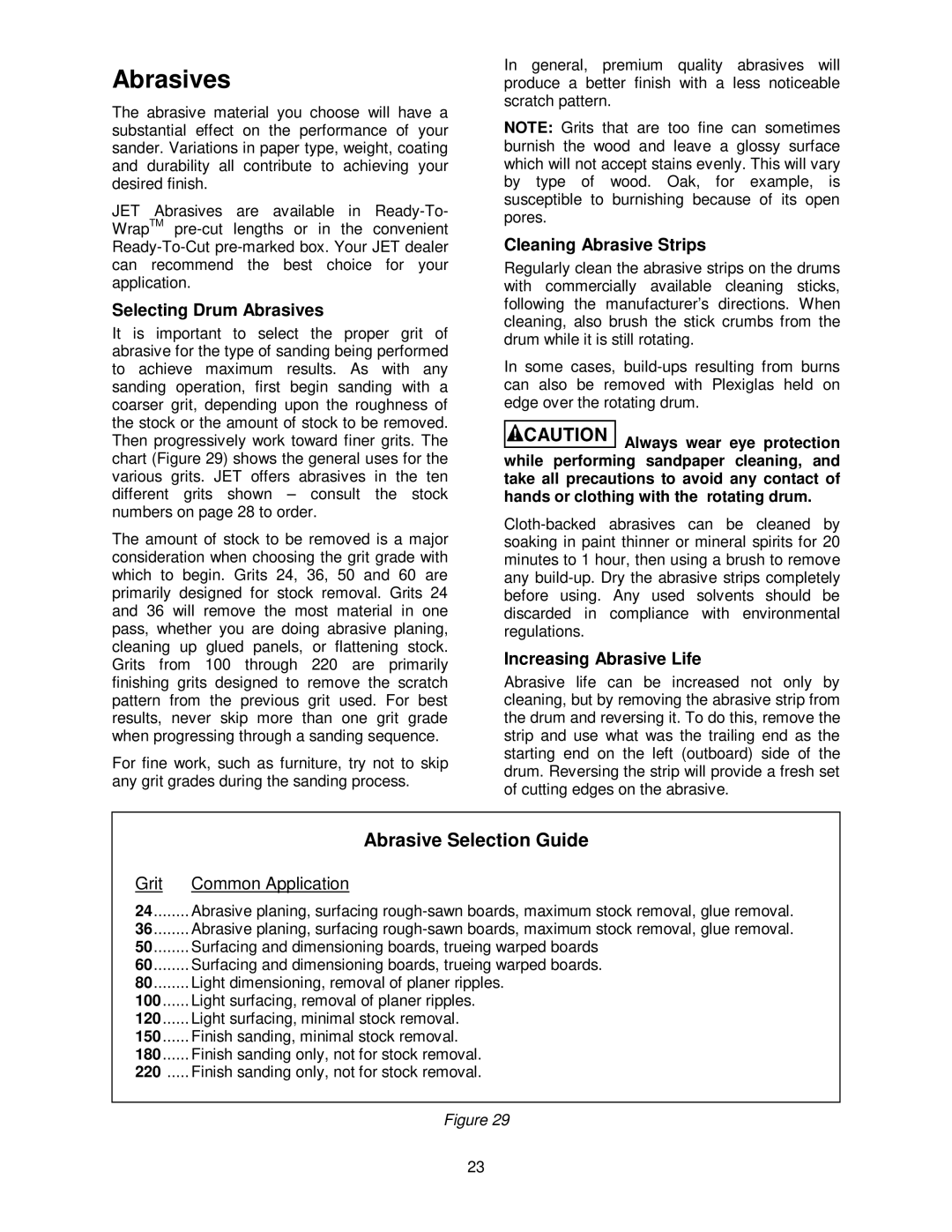
Abrasives
The abrasive material you choose will have a substantial effect on the performance of your sander. Variations in paper type, weight, coating and durability all contribute to achieving your desired finish.
JET Abrasives are available in
Selecting Drum Abrasives
It is important to select the proper grit of abrasive for the type of sanding being performed to achieve maximum results. As with any sanding operation, first begin sanding with a coarser grit, depending upon the roughness of the stock or the amount of stock to be removed. Then progressively work toward finer grits. The chart (Figure 29) shows the general uses for the various grits. JET offers abrasives in the ten different grits shown – consult the stock numbers on page 28 to order.
The amount of stock to be removed is a major consideration when choosing the grit grade with which to begin. Grits 24, 36, 50 and 60 are primarily designed for stock removal. Grits 24 and 36 will remove the most material in one pass, whether you are doing abrasive planing, cleaning up glued panels, or flattening stock. Grits from 100 through 220 are primarily finishing grits designed to remove the scratch pattern from the previous grit used. For best results, never skip more than one grit grade when progressing through a sanding sequence.
For fine work, such as furniture, try not to skip any grit grades during the sanding process.
In general, premium quality abrasives will produce a better finish with a less noticeable scratch pattern.
NOTE: Grits that are too fine can sometimes burnish the wood and leave a glossy surface which will not accept stains evenly. This will vary by type of wood. Oak, for example, is susceptible to burnishing because of its open pores.
Cleaning Abrasive Strips
Regularly clean the abrasive strips on the drums with commercially available cleaning sticks, following the manufacturer’s directions. When cleaning, also brush the stick crumbs from the drum while it is still rotating.
In some cases,
![]() Always wear eye protection while performing sandpaper cleaning, and take all precautions to avoid any contact of hands or clothing with the rotating drum.
Always wear eye protection while performing sandpaper cleaning, and take all precautions to avoid any contact of hands or clothing with the rotating drum.
Increasing Abrasive Life
Abrasive life can be increased not only by cleaning, but by removing the abrasive strip from the drum and reversing it. To do this, remove the strip and use what was the trailing end as the starting end on the left (outboard) side of the drum. Reversing the strip will provide a fresh set of cutting edges on the abrasive.
| Abrasive Selection Guide |
Grit | Common Application |
24 | Abrasive planing, surfacing |
36 | Abrasive planing, surfacing |
50 | Surfacing and dimensioning boards, trueing warped boards |
60 | Surfacing and dimensioning boards, trueing warped boards. |
80 | Light dimensioning, removal of planer ripples. |
100 | Light surfacing, removal of planer ripples. |
120 | Light surfacing, minimal stock removal. |
150 | Finish sanding, minimal stock removal. |
180 | Finish sanding only, not for stock removal. |
220 | Finish sanding only, not for stock removal. |
Figure 29
23
